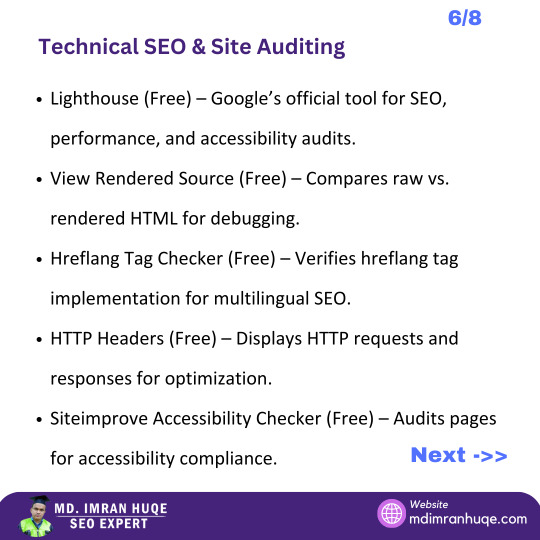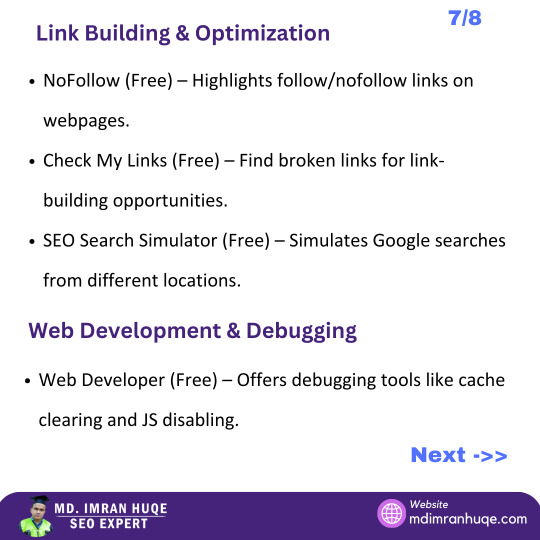#Website Cache Checker Tool
Explore tagged Tumblr posts
Text
All-in-One SEO Tools: Boost Rankings, Traffic, and Visibility
Boost Your SEO Success with Our Comprehensive Bono SEO Tools. Discover Keywords, Optimize Content, and Skyrocket Rankings. Try It Today!

#digitalmarketing#seo#local seo#seo agency#seo expert#seo services#bonoseotools#mozranktracker#youtube tools#website seo#website services#seo tools#backlink checker#da pa checker#domain authority checker#wordpress theme detector#google cache checker#google index checker#credit card generator#hosting checker#robot.txt generator#article rewriter#domain age checker#page authority checker#youtube description generator
0 notes
Link
Google Cache Checker - Monitor Your Website's Google Indexing
#Google Cache Checker#Free Micro Tools#Google indexing#SEO tools#website caching#SEO strategy#search engine indexing
0 notes
Text
Learn about negative SEO tactics and how to protect your website from malicious actions
In today’s highly competitive online landscape, businesses and website owners face not only the challenge of optimizing their websites for search engines but also the threat of negative SEO tactics. Negative SEO refers to the practice of using unethical and malicious strategies to harm a competitor’s website’s search engine rankings and online reputation. This dark side of search engine optimization can lead to devastating consequences for innocent website owners.
In this article, we will explore various negative SEO tactics and provide valuable insights on how to safeguard your website from such attacks.
Link Spamming and Manipulation
One of the most common negative SEO tactics is the mass creation of low-quality, spammy backlinks pointing to a targeted website. These malicious backlinks can lead search engines to believe that the website is engaging in link schemes, resulting in penalties and ranking drops. Website owners must regularly monitor their backlink profiles to identify and disavow any toxic links.
Content Scraping and Duplication
Content scraping involves copying content from a target website and republishing it on multiple other sites without permission. This can lead to duplicate content issues, harming the original website’s search rankings. Regularly monitoring your content for plagiarism and submitting DMCA takedown requests can help address this problem.
Fake Negative Reviews
Negative SEO attackers may leave fake negative reviews on review sites and business directories to damage a website’s reputation. Monitoring and responding to reviews promptly can help mitigate the impact of such attacks.
Distributed Denial of Service (DDoS) Attacks
DDoS attacks overload a website’s server with an excessive amount of traffic, causing it to become slow or crash. Implementing DDoS protection services can help safeguard your website against such attacks.
Regularly Monitor Backlinks
Use tools like Google Search Console and third-party SEO software to monitor your website’s backlink profile. Regularly review and disavow toxic links to prevent negative SEO attacks based on link spamming.
Secure Your Website
Ensure your website is secure with HTTPS encryption and robust security measures. This will help protect your website from hacking attempts and potential negative SEO attacks like content manipulation.
Frequently Check for Duplicate Content
Use plagiarism checker tools to identify if your content has been copied elsewhere. If you find duplicate content, reach out to the website owners to request removal or use the Google DMCA process.
Implement Review Monitoring
Keep an eye on reviews and mentions of your brand across various platforms. Respond professionally to negative reviews and report fake reviews to the respective platforms for removal.
Optimize Website Performance
A fast-loading website can better withstand DDoS attacks. Optimize your website’s performance by compressing images, using caching, and leveraging Content Delivery Networks (CDNs).
Regularly Backup Your Website
Frequent website backups will ensure that even if an attack occurs, you can quickly restore your website to its previous state without losing valuable data.
Use Webmaster Tools and Analytics
Stay vigilant by setting up alerts in Google Webmaster Tools and Google Analytics. These alerts can notify you of sudden drops in website traffic or other suspicious activities.
Conclusion
As the digital landscape continues to evolve, negative SEO tactics remain a persistent threat. Understanding these malicious strategies and proactively taking steps to protect your website is crucial for every website owner.
Discover countermeasures against negative SEO tactics, safeguarding your site from harm. Shield your website with insights from an experienced SEO company in Chandigarh for robust defense strategies.
2 notes
·
View notes
Text
Top SEO Plugins for WordPress You Should Use in 2025

Having a WordPress website is only the beginning—getting it discovered by search engines is where the real magic happens. With millions of websites competing for attention, optimizing your site for SEO is essential.
Thankfully, WordPress has an incredible range of SEO plugins that simplify the process. Whether you’re a blogger, business owner, or eCommerce seller, these tools help you rank higher, drive more traffic, and grow faster.
In this guide, we’ll cover the top SEO plugins for WordPress in 2025, how they work, and why you should consider installing them. For professional setup, a trusted WordPress Development Company in Udaipur can help you implement them flawlessly.
1. Yoast SEO
Best for: All-purpose SEO, beginners to advanced users
Yoast remains one of the most popular SEO plugins for WordPress, and in 2025, it’s better than ever.
Key Features:
On-page SEO suggestions
Keyword optimization
XML sitemap generation
Meta title and description editor
Breadcrumbs and canonical URLs
Yoast offers a real-time SEO analysis tool that guides you as you create content—perfect for bloggers and marketers alike.
Free version available | Premium from $99/year
2. Rank Math
Best for: Power users and those who want more control
Rank Math is quickly becoming the new favorite in the WordPress SEO world—and for good reason.
What sets it apart:
Track up to 5 keywords per post (even in the free version)
Built-in schema markup
Advanced redirection manager
Integration with Google Search Console & Analytics
Local SEO module for businesses
It’s powerful, lightweight, and packed with features that were previously only available in paid plugins.
Free version available | Pro from $59/year
3. All in One SEO (AIOSEO)
Best for: Business websites, eCommerce stores
AIOSEO is another long-standing plugin trusted by millions. Its latest 2025 update focuses on performance and deeper WooCommerce integration.
Highlights:
TruSEO on-page analysis
Smart XML sitemaps
SEO audit checklist
WooCommerce SEO tools
Social media integration with Open Graph and Twitter Cards
The setup wizard makes it easy to configure in minutes—ideal for beginners.
Free version available | Pro from $49/year
4. SEOPress
Best for: Developers and agencies
SEOPress is a clean, lightweight, and privacy-focused SEO plugin that rivals both Yoast and Rank Math in power.
Notable features:
Content analysis and optimization tips
Schema (structured data) integration
Broken link checker
Google Analytics and Tag Manager integration
White-label options for agencies
If you want an ad-free, developer-friendly SEO solution, SEOPress is a strong contender.
Free version available | Pro from $49/year
5. Schema Pro
Best for: Advanced schema markup
Structured data helps Google understand your content better—and plugins like Schema Pro make it easy to implement.
What it does:
Adds rich snippets (reviews, FAQs, recipes, etc.)
Supports 20+ schema types
Integrates with Elementor and other builders
Visual interface for mapping schema fields
Great for businesses and blogs that want to improve click-through rates with rich results.
Premium only | Starts at $79/year
6. Redirection
Best for: Managing 301 redirects and broken links
SEO isn’t just about adding keywords—it’s also about maintaining clean URLs. Redirection helps manage URL changes and avoid 404 errors.
Key Features:
Easy setup of 301 redirects
Monitor 404 errors
Conditional redirects based on login status, browser, or referrer
Full logging for troubleshooting
It’s a lightweight plugin that plays a big role in preserving SEO equity during site migrations or redesigns.
Completely free
7. WP Rocket (for Speed & Core Web Vitals)
Best for: SEO through performance optimization
While not an SEO plugin in the traditional sense, WP Rocket improves page speed and Core Web Vitals, both of which are crucial for SEO rankings in 2025.
Features:
Page and browser caching
File minification
Lazy loading for images
CDN support
Database cleanup
Google ranks fast sites higher, so using WP Rocket in tandem with SEO plugins is a smart strategy.
Premium only | Starts at $59/year
8. Broken Link Checker
Best for: Fixing dead links that hurt SEO
Broken links frustrate users and damage your SEO. This plugin scans your posts, pages, and comments to detect and fix them.
Benefits:
Scans internal and external links
Notifies you via dashboard and email
Offers quick editing interface
It’s a must-have for content-heavy websites and blogs.
Free version available
9. Google Site Kit
Best for: Integrating Google’s tools into WordPress
Google Site Kit brings essential SEO tools right into your WordPress dashboard.
What it connects:
Google Search Console
Google Analytics
PageSpeed Insights
Google AdSense
Tag Manager
Use it to monitor traffic, performance, and crawl errors in one place—no code needed.
Completely free
10. Squirrly SEO
Best for: Beginners and content creators
Squirrly is like having an SEO coach inside your dashboard. It’s ideal for non-technical users who want real-time tips as they write.
Features:
SEO Live Assistant with suggestions
Keyword research built-in
Weekly site audits
Competitor analysis
Google SERP checker
It also helps you optimize content for both users and search engines.
Free version available | Pro from $71.99/year
Final Thoughts
If you’re using WordPress, you already have a head start in SEO—but the right plugins can elevate your site’s performance, visibility, and traffic dramatically.
0 notes
Text
Prevent HTTP Response Splitting in Symfony
HTTP Response Splitting is a critical web vulnerability that can enable attackers to manipulate HTTP headers and inject malicious responses. If you're building web applications with Symfony, understanding how to detect and prevent this vulnerability is crucial.

In this blog post, we’ll explore how HTTP Response Splitting works, how it affects Symfony apps, demonstrate it with practical coding examples, and show you how to defend against it effectively. We’ll also show how you can use our Website Vulnerability Scanner online free tool to test for it automatically.
➡️ Bonus: Don’t forget to check out our latest services at Pentest Testing Corp. and subscribe to our free Cybersecurity Newsletter on LinkedIn for weekly threat analysis and tips.
🔍 What Is HTTP Response Splitting?
HTTP Response Splitting occurs when an attacker manipulates unsanitized input that ends up in HTTP headers. By injecting CRLF (\r\n) characters, attackers can "split" the response into two or more responses, potentially injecting malicious content or redirecting users.
For example:
If user input is added directly to a header like:
$response->headers->set('Location', '/page?lang=' . $_GET['lang']);
And an attacker passes:
en%0d%0aContent-Length:%200%0d%0a%0d%0a<script>alert(1)</script>
The server will interpret it as two responses—opening the door for XSS or cache poisoning attacks.
⚠️ Symfony-Specific Risks
Symfony is a secure framework by design, but improper usage of its HTTPFoundation component can still introduce risks.
Bad Practice: Unvalidated input in headers
use Symfony\Component\HttpFoundation\Response; $lang = $_GET['lang']; $response = new Response(); $response->headers->set('Location', '/dashboard?lang=' . $lang); // Vulnerable $response->send();
If an attacker includes encoded CRLF characters in the lang parameter, it can split the response and inject malicious scripts.
✅ How to Prevent HTTP Response Splitting in Symfony
1. Use Built-In Symfony Escaping
Symfony automatically escapes header values. However, always sanitize user input:
use Symfony\Component\HttpFoundation\Response; use Symfony\Component\HttpFoundation\RedirectResponse; $lang = preg_replace('/[^a-z]/', '', $_GET['lang']); // sanitize $response = new RedirectResponse('/dashboard?lang=' . $lang); $response->send();
🛡️ Tip: Use Symfony’s UrlGeneratorInterface instead of manual string concatenation.
2. Avoid Direct Use of Superglobals
Using $_GET directly bypasses Symfony’s Request object:
Bad:$user = $_GET['user'];
Good:
use Symfony\Component\HttpFoundation\Request; $user = $request->query->get('user', 'default');
🛠️ Automatically Detect Response Splitting With Our Free Tool
You don’t have to find these vulnerabilities manually. Our free Website Security Checker at free.pentesttesting.com can scan your website for common misconfigurations, including HTTP Response Splitting.
📷 Screenshot of our Website Vulnerability Scanner homepage with URL bar visible.

Screenshot of the free tools webpage where you can access security assessment tools.
It analyzes the request/response cycle and reports header injection attempts, giving you detailed diagnostics on exploitable flaws.
📷 Screenshot of a sample report from the free tool to check Website Vulnerability.

An Example of a vulnerability assessment report generated with our free tool, providing insights into possible vulnerabilities.
🧪 Live Coding Demo: Exploiting Response Splitting (for educational use only)
Here’s a test route vulnerable to response splitting:
routes.yaml:
split_test: path: /split-test controller: App\Controller\SplitController::test
Controller:
// src/Controller/SplitController.php namespace App\Controller; use Symfony\Component\HttpFoundation\Response; use Symfony\Component\Routing\Annotation\Route; class SplitController { #[Route('/split-test')] public function test(): Response { $userInput = $_GET['lang'] ?? 'en'; $response = new Response(); $response->headers->set('X-Custom-Header', 'Language=' . $userInput); return $response; } }
Attack vector:
/split-test?lang=en%0d%0aSet-Cookie:%20hacked=true
Result: A new header is injected. This is what our free tool can detect automatically.
🧰 Best Practices to Harden Your Symfony App
Always use Symfony’s Request and Response classes
Avoid direct use of $_GET, $_POST, $_SERVER
Sanitize inputs using PHP’s filter_var or Symfony’s Validator component
Validate headers before setting them
Perform regular vulnerability scans
📚 More Learning Resources
Symfony Security Docs: https://symfony.com/doc/current/security.html
OWASP HTTP Response Splitting: https://owasp.org/www-community/attacks/HTTP_Response_Splitting
For more expert write-ups, visit our full blog archive at Pentest Testing Corp.
🚀 Try Our New Web App Penetration Testing Service
If your Symfony app is business-critical, we recommend a full professional assessment.
➡️ Explore our new service at Web App Penetration Testing Services — it includes:
Business logic testing
Framework-specific exploitation (like Symfony, Laravel)
Post-exploitation analysis
PDF vulnerability reports with CVSS scoring
Protect your users and your reputation.
📨 Subscribe to Our Cybersecurity Newsletter
Join over 10,000 developers and CISOs receiving weekly security insights.
📥 Subscribe via LinkedIn: https://www.linkedin.com/build-relation/newsletter-follow?entityUrn=7327563980778995713
—
🧠 Final Thought
HTTP Response Splitting is easy to overlook but dangerous if exploited. Use Symfony’s secure components, sanitize input rigorously, and scan your site often. Start now with our Free Website Security Scanner.
0 notes
Text

🔍 HTTP Header Checker — Free Web Diagnostic Tool Want to know what your website’s server is telling the world? Check all HTTP response headers in one click. 💡 View status codes 💡 Inspect caching & content-type 💡 Diagnose redirects Use our free tool here: https://cyberclipper.com/http-header-checker/ #CyberClipper #WebDevTools #HTTPHeaderChecker #TechSEO #WebsiteAudit #DeveloperTools
0 notes
Text
Track Your Website’s Google Ranking with ToolsPing’s Free SERP Checker Tool
In the digital age, visibility on Google determines the success or failure of a website. Whether you run a blog, an eCommerce store, or a corporate website, your position on search engine results pages (SERPs) can directly affect your traffic, leads, and ultimately your revenue. Understanding where your site ranks for targeted keywords is vital — and that’s where ToolsPing’s Free SERP Checker Tool comes in.
At ToolsPing, we offer a powerful yet simple solution for anyone looking to monitor and optimize their SEO performance without the hassle of registration, downloads, or expensive software subscriptions. Our Free SERP Checker Tool is designed for immediate use, offering real-time insights into your keyword rankings on Google — completely free of charge.

What Is a SERP Checker Tool and Why Do You Need One?
A SERP (Search Engine Results Page) Checker Tool is an SEO utility that allows you to analyze where your website ranks on Google for a specific keyword or search phrase. These tools are essential for:
Tracking SEO campaigns
Analyzing keyword performance
Monitoring competitors
Understanding organic visibility
Identifying SEO opportunities
Whether you're an SEO specialist or a business owner, a Free SERP Checker Tool provides essential data that guides your content strategies and optimization efforts.
Introducing ToolsPing’s Free SERP Checker Tool
Our Free SERP Checker Tool at ToolsPing is an intuitive, easy-to-use platform tailored for users who want instant results without any learning curve or login barrier.
Key Features:
Instant Keyword Position Tracking Enter your target keyword and domain, and our tool will instantly display where your site ranks on Google.
No Sign-Up Required Start checking your rankings right away — no email, no registration, no waiting.
Multi-Device Compatibility Use it on desktop, tablet, or mobile. Our platform is responsive and optimized for all devices.
Global Search Options Track keyword rankings in various countries and regions to support your international SEO strategies.
Clean, User-Friendly Interface Our tool is designed for clarity. Whether you're a seasoned SEO expert or a beginner, you’ll navigate with ease.
Why Use ToolsPing’s Free SERP Checker Tool Over Others?
Many SERP tools on the market come with hidden limitations — usage caps, mandatory sign-ups, or premium-only features. At ToolsPing, we offer complete transparency and accessibility.
Here’s why we stand out:
Truly Free: No hidden charges, no freemium traps — just pure SERP data at no cost.
Real-Time Results: Get accurate, live Google ranking data, not outdated cached info.
Unlimited Searches: Check as many keywords and domains as you want, any time.
Privacy Guaranteed: No data tracking, no personal information collected.
This makes our Free SERP Checker Tool the ideal choice for students, small business owners, digital marketers, and SEO professionals alike.
How to Use the Free SERP Checker Tool on ToolsPing
Getting started is as easy as it gets:
Visit ToolsPing’s Free SERP Checker Tool page.
Enter your domain name (e.g., www.yoursite.com).
Type in the keyword you want to check.
Select your target country (optional).
Click the "Check SERP" button.
Within seconds, you’ll see exactly where your website ranks for that keyword on Google.
Benefits of Regularly Checking Your Google Rankings
Using a Free SERP Checker Tool regularly ensures that you stay informed about your SEO health. Here are some of the key benefits:
Track Progress Over Time
Monitor how your rankings improve as you implement new SEO strategies or publish fresh content.
Identify Drop-Offs Quickly
Spot when rankings fall so you can take immediate corrective action.
Understand Competitor Movements
See how you compare with competitors and respond to shifts in search position.
Optimize Content Efficiently
Focus your optimization efforts on keywords that matter most and yield the best ROI.
Improve Local and Global Reach
Track location-specific keywords to tailor content for regional SEO campaigns.
Who Should Use ToolsPing’s Free SERP Checker Tool?
This tool is perfect for:
Freelancers and bloggers optimizing their articles and content
Business owners wanting to track product or service visibility
SEO agencies managing client keyword positions
eCommerce websites analyzing product keyword performance
Students learning about search engine marketing in real time
If you care about search visibility, you need a reliable, real-time, and Free SERP Checker Tool — and ToolsPing delivers exactly that.
Boost Your SEO Strategy with ToolsPing
Ranking well on Google doesn’t happen by chance. It requires consistent effort, strategic insights, and reliable tools. With ToolsPing’s Free SERP Checker Tool, you get the clarity and direction needed to improve your search performance without paying a cent.
Our mission is to empower webmasters, content creators, and digital marketers by providing fast, accurate, and free SEO tools that make a difference.
Don’t let your website’s potential go untapped. Stay on top of your rankings and adapt your SEO strategies with real data. ToolsPing is your trusted partner in navigating the ever-changing world of search engine optimization.
0 notes
Text
How to Use SEOsiteCheckup to Improve Your Website's SEO

To improve traffic and visibility on the web today, search engine optimization is inevitable with respect to your website. Such an optimized website not only has higher ranking on search engine results pages (SERPs) but also heightens user experience. You can have all of this if you use necessary SEO tools. SEOsiteCheckup is one among such powerful tools, as it is a complete website SEO checker that makes a thorough analysis of your site's performance. This article helps you to learn how to do an SEO audit using SEOsiteCheckup and how to implement suitable improvements.
What is SEOsiteCheckup?
SEOsiteCheckup is an easy-to-use SEO checker website that analyzes various aspects of your site’s SEO health. It provides a detailed report on critical factors such as site speed, security, mobile-friendliness, backlinks, and keyword optimization. By using this tool, you can quickly identify areas that need improvement and enhance your site's ranking on search engines.
How to Perform an SEO Audit Using SEOsiteCheckup
Conducting an SEO audit with SEOsiteCheckup is a simple process that can be completed in a few steps:
Step 1: Visit the SEOsiteCheckup Website
To begin, go to SEOsiteCheckup. This website provides an interface where you can input your domain for a detailed SEO analysis.
Step 2: Enter Your Website URL
On the homepage, you'll find a search bar where you can enter your website’s URL. Click on "Checkup" to start the analysis.
Step 3: Analyze the SEO Report
Once the scan is complete, SEOsiteCheckup will generate a report detailing various aspects of your website’s SEO performance. The report includes:
Meta Tags Optimization – Checks if your title tags and meta descriptions are properly optimized.
Keyword Usage – Evaluates keyword presence and relevance in your content.
Mobile Friendliness – Tests if your website is optimized for mobile devices.
Page Speed – Analyzes loading times and provides suggestions for improvement.
Backlink Profile – Provides insights into your website's inbound and outbound links.
Security Issues – Checks for SSL certification and potential security vulnerabilities.
Interpreting Your SEO Audit Report
The SEOsiteCheckup report categorizes results into three main areas:
Passed Checks: These indicate areas where your site is performing well.
Warnings: These suggest improvements that can enhance performance but are not critical issues.
Failed Checks: These highlight major problems that need immediate attention.
By carefully analyzing these sections, you can prioritize necessary fixes to improve your SEO health.
Implementing SEO Improvements
After reviewing the SEOsiteCheckup report, it's time to take action. Here are some key areas to focus on:
1. Optimize Meta Tags and Content
Ensure each page has a unique and descriptive title tag and meta description.
Use relevant keywords naturally within your content to improve visibility.
2. Improve Website Speed
Compress images to reduce file size without compromising quality.
Minimize HTTP requests and enable browser caching.
Use a content delivery network (CDN) to speed up loading times.
3. Enhance Mobile-Friendliness
Implement a responsive design to ensure your site adjusts to different screen sizes.
Optimize images and fonts for faster loading on mobile devices.
4. Strengthen Website Security
Install an SSL certificate to secure user data and improve trust.
Update software and plugins regularly to prevent vulnerabilities.
5. Build High-Quality Backlinks
Create valuable content that encourages other sites to link back to you.
Engage in guest posting on reputable websites within your industry.
Avoid spammy or low-quality backlinks that can harm your SEO ranking.
Why Regular SEO Audits are Important
SEO is an ongoing process, and regular audits are essential to maintaining and improving your website’s performance. Search engines frequently update their algorithms, which means what works today may not be effective tomorrow. By using SEO tools like SEOsiteCheckup, you can:
Identify and fix SEO issues before they impact your rankings.
Keep up with industry trends and algorithm changes.
Continuously improve user experience and site performance.
Conclusion
Optimizing your website for search engines is a continuous effort that requires the right tools and strategies. SEOsiteCheckup is a powerful SEO checker website that simplifies the SEO audit process by identifying key issues and providing actionable recommendations. By regularly analyzing and improving your website using this tool, you can boost search rankings, increase traffic, and enhance user experience. Start optimizing today with SEOsiteCheckup and take your website’s SEO performance to the next level!
Read More : https://siteanalysistool.com/domain/seositecheckup.com
0 notes
Text
```markdown
The Ultimate Guide to SEO Scripts on GitHub
In the vast world of digital marketing, Search Engine Optimization (SEO) plays a pivotal role in driving organic traffic and improving online visibility. One powerful tool that has emerged to aid in this process is GitHub, a platform not only for code hosting but also for sharing and collaborating on projects. In this article, we will explore some of the best SEO scripts available on GitHub that can help you enhance your website's performance and ranking.
Why Use SEO Scripts from GitHub?
1. Community-Driven: GitHub is a community-driven platform where developers share their knowledge and tools. This means the scripts are often well-maintained and updated regularly.
2. Customizability: Since these scripts are open-source, you have the flexibility to modify them according to your specific needs.
3. Cost-Effective: Many of these scripts are free to use, making them an affordable solution for businesses of all sizes.
Top SEO Scripts on GitHub
1. SEO Audit Tool
This script allows you to perform a comprehensive audit of your website, identifying issues that could be affecting your SEO. It checks for broken links, missing meta tags, duplicate content, and more. By addressing these issues, you can improve your site's overall health and search engine rankings.
2. Keyword Research Tool
Keyword research is crucial for any SEO strategy. This script helps you find relevant keywords for your content by analyzing search trends and competitor data. With accurate keyword data, you can create content that resonates with your target audience and ranks higher in search results.
3. Backlink Checker
Backlinks are a significant factor in determining a website's authority and ranking. This script allows you to check the quality and quantity of backlinks pointing to your site. It also provides insights into which sites are linking to you and how those links are structured.
4. Site Speed Optimization Script
Page speed is another critical factor in SEO. This script helps you optimize your website's loading time by compressing images, minifying CSS and JavaScript files, and leveraging browser caching. Faster load times lead to better user experience and higher search engine rankings.
Conclusion
The world of SEO is constantly evolving, and staying ahead requires the right tools and strategies. By leveraging the power of GitHub, you can access a wealth of resources to improve your website's SEO. Whether you're looking to audit your site, conduct keyword research, or optimize your page speed, there's a script on GitHub that can help.
What are some other SEO tools or strategies you've found useful? Share your thoughts and experiences in the comments below!
```
加飞机@yuantou2048

谷歌留痕
Google外链代发
0 notes
Text
Top 20 SEO Chrome Extensions: Features & Best Uses








Why Use Chrome Extensions for SEO? Chrome extensions enhance SEO workflows by offering: Convenience – Quick installation and seamless integration with Chrome. Efficiency – Streamlined access to essential SEO tools. Real-Time Data – Instant insights for better decision-making. Diverse Functionality – A range of tools catering to various SEO needs.
Best SEO Chrome Extensions
Content Optimization & AI Assistance ContentShake AI Writing Wizard (Free + in-app purchases) – Improves grammar, tone, and readability. Works with Google Docs, email, and social media. Generates AI-powered content. AIPRM for ChatGPT (Free, paid plans from $20/month) – Provides 4,900+ SEO content templates (titles, FAQs, press releases, etc.), supports 50+ languages, and filters by topic and activity.
Keyword Research & Analysis Keyword Surfer (Free) – Displays keyword data, search volume, and CPC directly in Google Search. Keywords Everywhere (Free/Paid) – Offers keyword research insights, including volume, CPC, and competition. Glimpse (Free/Paid) – Enhances Google Trends with search volume data.
SEO Metrics & On-Page Analysis SEO Pro Extension (Free) – Analyzes on-page data, links, and schema. SEO META in 1 Click (Free) – Displays metadata, links, and images for SEO evaluation. META SEO Inspector (Free) – Checks for metadata issues and suggests optimizations. Detailed SEO (Free) – Provides insights into meta details, headings, and links. SEO Minion (Paid) – Assesses on-page SEO and verifies hreflang tags.
Technical SEO & Site Auditing Lighthouse (Free) – Google’s official tool for SEO, performance, and accessibility audits. View Rendered Source (Free) – Compares raw vs. rendered HTML for debugging. Hreflang Tag Checker (Free) – Verifies hreflang tag implementation for multilingual SEO. HTTP Headers (Free) – Displays HTTP requests and responses for optimization. Siteimprove Accessibility Checker (Free) – Audits pages for accessibility compliance.
Link Building & Optimization NoFollow (Free) – Highlights follow/nofollow links on webpages. Check My Links (Free) – Find broken links for link-building opportunities. SEO Search Simulator (Free) – Simulates Google searches from different locations.
Web Development & Debugging Web Developer (Free) – Offers debugging tools like cache clearing and JS disabling.
Boost Your SEO Efficiency These Chrome extensions streamline SEO tasks, from content creation and keyword research to technical optimization and site auditing. By leveraging these tools, you can enhance your SEO strategy, improve search rankings, and automate essential processes.
This version improves readability, categorizes tools for clarity, and makes the content more engaging. Let me know if you’d like any tweaks! 🚀
To get more information about SEO Chrome Extensions, you can visit now my website:-
jfssoftware.com
0 notes
Text
youtube
How to generate favicon & upload in wordpress in 2025 ?
Step 1: Generate a Favicon
A favicon is a small icon that appears in the browser tab and helps with branding. You can create one using the following methods:
Method 1: Using Online Favicon Generators
You can use free online tools to generate a favicon:
favicon.io
RealFaviconGenerator.net
Favicon-Generator.org
Method 2: Creating Your Own Favicon
Design a 512x512 px image using tools like Canva, Photoshop, or Figma.
Convert it to .ico format using an online converter if needed.
Step 2: Upload Favicon in WordPress
Method 1: Using WordPress Customizer (Recommended)
Go to your WordPress Dashboard.
Navigate to Appearance > Customize.
Click on Site Identity.
Find the Site Icon section.
Click Select Image, upload your favicon (512x512px recommended), and Save Changes.
Method 2: Manually Uploading via FTP
Upload the favicon.ico file to your website’s root directory via cPanel or FTP (FileZilla).
Add the following code inside the <head> section of your theme’s header.php:htmlCopyEdit<link rel="icon" type="image/x-icon" href="https://yourwebsite.com/favicon.ico">
Save and upload the file.
Method 3: Using a WordPress Plugin
You can use plugins like:
Favicon by RealFaviconGenerator
WP Favicon Editor
Install the plugin from Plugins > Add New.
Upload your favicon and configure the settings.
Step 3: Clear Cache & Verify
Clear your browser cache and check the favicon by opening your website in incognito mode.
Use Favicon Checker to verify if it's working correctly.
0 notes
Text
HTTP status code checker
Quick and Easy Steps to Use Our HTTP Status Code Checker
Step 1: Enter your URL
To commence your journey to a clearer understanding of your website’s health, begin by entering the URL you wish to verify into the designated text field. It’s a straightforward process: simply copy and paste the full website address, ensuring it includes either the HTTP:// or HTTPs:// protocol as appropriate. Whether you’re looking to check a single URL or multiple ones at once, our HTTP Status Code Checker stands ready to facilitate your needs. Just input the address, and you’re set for the next step.
Step 2: Receive Real-Time Results
Upon submitting your URLs, our HTTP Status Code Checker swings into action. With a single click on the “Check” button, the magic begins: the tool runs in real-time, processing the input and swiftly providing you with a comprehensive report. It’s a matter of seconds before you can observe the status codes for each URL, information that sheds light on the health and accessibility of your web pages. No need to wait or refresh — the results unfold right before your eyes, preparing you to take any necessary action instantly.
How to Read Your HTTPS Status Report?
Understanding your HTTPS status report is critical for diagnosing and rectifying any issues your website might face. Upon generating the status report, you’ll be presented with details often including HTTP status codes, server response time, and header information.
HTTP status codes are categorized into series: 2xx indicates success, 3xx denotes redirects, 4xx signals client errors, and 5xx are server errors. It’s important to recognize that codes like 404 mean a page is not found, whereas 200 signifies successful retrieval.
Server response time can reveal how quickly your server is responding to requests—a key factor in user experience and search engine ranking.
Lastly, HTTP header information unveils backend communication processes between browsers and servers. It provides the type of server, content type, cache control policies, and more—which are vital for optimizing website performance.
What Infidigit’s HTTP Status Tool Checks?
HTTP status of URL
When you utilize our HTTP Status Code Checker, the foundational piece of information you’ll receive is the HTTP status of the URL you’re investigating. This status tells you whether a web page is functioning correctly or encountering issues. For instance, a status code of 200 means everything is operating smoothly — the URL is accessible, and the requested resource is successfully delivered. On the other hand, the presence of a 404 indicates a problem; the requested page cannot be found, signifying a potential dead link or a removed page. It’s critical to regularly monitor these statuses because they can have a significant impact on user experience and search engine optimization.
HTTP header code
The HTTP header code, a component of the HTTP status report, provides a wealth of diagnostic information. Beyond the HTTP status code, the header includes metadata such as the server type, content type, caching policies, and set cookies, amongst others. This metadata assists in understanding how web pages are served and processed. For instance, cache-control directives in the header can inform browsers how to handle caching, which directly affects page load times and efficiency. By reviewing the HTTP header code with our tool, you’ll gain deeper insight into the server behavior and configurations that impact the functionality and performance of your website.
Host
The host essentially indicates the domain serving the requested URL, which is crucial to verify that your content is being served from the expected source. If discrepancies are found between the host and the domain, it could suggest misconfigurations or potential security concerns that need to be addressed. Recognizing the correct hostname ensures that traffic is directed appropriately and helps maintain the security and reliability of your web presence.
The Importance of Regular URL Checks
Stay Ahead with Consistent HTTP status Monitoring
Consistent HTTP status monitoring is essential for maintaining a healthy and thriving website. Regular checks alert us to the presence of any issues, such as broken links, page not found errors, or server problems before they negatively impact the user experience or SEO rankings. With timely detection and resolution of these problems, we can ensure uninterrupted website availability and performance, contributing to better user engagement and potentially higher search engine visibility. Staying proactive with HTTP status monitoring is not just about fixing problems; it’s about offering a seamless, quality experience to every visitor and maintaining the integrity of your online domain.
Reduce Downtime and Maintain Optimal Performance
Through vigilant monitoring of HTTP status codes, we take an important step toward minimizing downtime. By being informed of error codes as soon as they occur, we can quickly pinpoint and address issues, reducing the time our website is inaccessible or performing sub-optimally. This proactive approach not only enhances the user experience by ensuring they can always access the content they need, but it also aids in maintaining our website’s SEO standing, as frequent downtimes can negatively impact search engine rankings. In essence, our HTTP status checker becomes a crucial ally in ensuring our digital presence is robust, reliable, and consistently delivers optimal performance.
0 notes
Text
Host Header Injection in Symfony Explained: Risks, Exploits & Fixes
Host Header Injection is a subtle yet critical web vulnerability that developers often overlook—especially in modern frameworks like Symfony. In this blog post, we’ll explore what Host Header Injection is, how it can be exploited in Symfony applications, how to prevent it, and how you can test your own website using our website vulnerability scanner online free.

This article includes coding examples, screenshots, and references to help you fully understand the impact and defense mechanisms.
👉 You can find more blogs like this on our official blog portal at Pentest Testing Corp.
🕵️♂️ What is Host Header Injection?
Host Header Injection occurs when a web application uses the value of the Host header in an unsafe way—without validation or sanitization. This can lead to:
Web cache poisoning
Password reset poisoning
Misrouting to malicious domains
Bypass of security mechanisms
Symfony applications are susceptible when routing logic or URL generation depends on the Host header.
🚨 Real-World Exploit Scenario in Symfony
Here’s an example to show how this could become a problem:
Symfony supports generating URLs via the generateUrl() method. If improperly configured, it can trust the Host header.
Consider this controller code:
// src/Controller/ResetController.php use Symfony\Component\Routing\Generator\UrlGeneratorInterface; public function resetPassword(Request $request, UrlGeneratorInterface $urlGenerator) { $userEmail = $request->get('email'); $user = $this->getUserByEmail($userEmail); $token = bin2hex(random_bytes(32)); $resetUrl = $urlGenerator->generate('reset_password', ['token' => $token], UrlGeneratorInterface::ABSOLUTE_URL); mail($user->getEmail(), "Reset Your Password", "Click here: $resetUrl"); }
Now, if the Host header is spoofed (e.g., evil.com), then the generated link becomes:
https://evil.com/reset-password?token=abc123
📌 The attacker now has full control over the reset link sent to the user!
🧪 How to Reproduce Host Header Injection in Symfony
You can test this vulnerability using curl:curl -H "Host:
evil.com" https://your-symfony-app.com/forgot-password
Or via Burp Suite by intercepting and modifying the Host header.
🛡️ How to Fix Host Header Injection in Symfony
Symfony lets you control trusted hosts and headers. Add this to your configuration (typically in framework.yaml):
# config/packages/framework.yaml framework: trusted_hosts: ['^www\.yourdomain\.com$']
Also set trusted proxies and headers explicitly:
// public/index.php use Symfony\Component\HttpFoundation\Request; Request::setTrustedProxies(['127.0.0.1'], Request::HEADER_X_FORWARDED_ALL); Request::setTrustedHosts(['^www\.yourdomain\.com$']);
➡️ This ensures Symfony ignores spoofed Host headers from untrusted sources.
🛠️ Automated Vulnerability Detection Using Free Tool
You don’t need to manually test everything—use our website vulnerability checker to scan for Host Header Injection and 30+ vulnerabilities:

Screenshot of the free tools webpage where you can access security assessment tools.
After scanning, you’ll receive a detailed report to check Website Vulnerability that flags potential issues like Host Header Injection, insecure headers, XSS, and more.

An Example of a vulnerability assessment report generated with our free tool, providing insights into possible vulnerabilities.
💼 Need Professional Security Testing?
If you're managing sensitive data or enterprise-level Symfony applications, consider investing in a full Web App Penetration Testing service.
✅ Get in-depth vulnerability detection ✅ Manual + Automated Testing ✅ OWASP Top 10 and business logic coverage
📍 Visit: Web App Penetration Testing Services
📰 Stay Updated on Security Insights
Want more content like this? Get new blog posts, vulnerabilities, and code samples directly in your inbox.
🔔 Subscribe on LinkedIn
👨💻 Final Thoughts
Host Header Injection is one of those “low-effort, high-impact” vulnerabilities that developers tend to miss, especially in secure-by-default frameworks like Symfony. By validating the Host header, restricting trusted proxies, and using tools like https://free.pentesttesting.com, you can reduce risk drastically.
💡 Keep learning—check our full blog archive here: https://www.pentesttesting.com/blog/
🔄 Don’t forget to share this post with fellow developers and security professionals.
🧠 Knowledge is your first line of defense.
1 note
·
View note
Text
Best Shopify Optimization Services for Faster Load Times & Higher Rankings
In the present serious online business scene, having a slow-loading Shopify store can hurt your rankings, changes, and in general user experience. To remain ahead, it is vital to put resources into Shopify optimization services. A very optimized store guarantees quicker load times, better website design enhancement rankings, and further developed user commitment. In this aid, we'll investigate the best Shopify optimization services to assist you with improving Shopify store speed and upgrading your online achievement.

Why Speed Optimization Matters for Shopify Stores
Prior to plunging into the best service, how about we comprehend the reason optimizing your Shopify store speed is fundamental?
Higher Search Engine Rankings: Google focuses on quick-loading sites in search rankings.
Better User Experience: Users are bound to remain on a site that heaps inside 2–3 seconds.
Increased conversion rates: Studies demonstrate that a 1-second deferral can decrease transformations by 7%
Lower Bounce Rates: Quicker stores keep users connected with and decrease bounce rates.
Improved Mobile Performance: With mobile-first indexing, speed optimization is a must.
Now, let's explore the best Shopify optimization services to help you achieve these benefits.
Top Shopify Optimization Services for Faster Load Times & Higher Rankings
1. Shopify Speed Optimization by PageFly
Page Fly is a trusted name when it comes to Shopify page building and speed optimization. Their service includes:
Code minification & compression
Image optimization
Lazy loading implementation
Unused script removal
This service ensures a seamless shopping experience while boosting your Google Page Speed score.
2. Tiny IMG: Image Compression & SEO Booster
Optimizing images is a key aspect of Shopify Optimization Services. Tiny IMG helps with:
Automatic image compression
Lazy loading for faster performance
SEO-friendly image optimization
Broken link checker
By reducing image sizes, Tiny IMG significantly improves load times without compromising quality.
3. Shopify Plus Speed Optimization Services
For high-traffic Shopify Plus stores, advanced optimization is necessary. Shopify Plus experts offer:
Advanced CDN setup
Server-side rendering (SSR) improvements
Backend performance enhancements
Custom script management
These techniques help large-scale stores maintain speed even with high visitor loads.
4. Minified: CSS & JavaScript Optimization
Minified helps store owners optimize Shopify store speed by reducing unnecessary code. This tool focuses on:
Minifying CSS and JavaScript files
Removing redundant scripts
Improving browser caching
By advancing your store's code, you can decrease page load times and further develop user engagement.
5. Nitro Pack: All-in-One Speed Optimization
Nitro Pack is one of the most comprehensive Shopify optimization services. It provides:
Automatic speed enhancement
Advanced caching solutions
Image & code optimization
Cloud-based CDN integration
This tool is excellent for store owners who want a hands-free speed optimization solution.
6. AMP by Shop Sheriff—Mobile Speed Booster
With Google’s mobile-first indexing, Accelerated Mobile Pages (AMP) can help your store rank higher. This service offers:
AMP-powered product pages
Faster mobile load speeds
Improved mobile UX
If mobile traffic is a major part of your sales, AMP by Shop Sheriff is a must-have.
7. Speed Boost: Expert Shopify Performance Service
Speed Boost is a Shopify-focused agency specializing in performance improvements. Their services include:
Manual performance audits
App & script optimization
Image and code compression
With a team of Shopify experts, Speed Boost ensures your store meets Google’s performance guidelines.
8. Shopify Store Optimization by WebEx
WebEx provides professional Shopify SEO and speed optimization services, such as:
Site speed audits
Custom optimization strategies
Technical SEO fixes
This help is great for storekeepers searching for a full-service way to deal with enhanced Shopify store speed and further develop rankings.
How to Choose the Best Shopify Optimization Service
With such countless choices accessible, how would you pick the right Shopify optimization services? Here are a few factors to consider:
Your store’s needs; identify whether you need basic speed enhancements or advanced backend optimizations.
Budget: A few services are free or low expense, while others require a venture.
Technical expertise: If you lean toward a hands-off approach, pick a completely managed solution.
Customer Reviews: Check user surveys and tributes to guarantee dependability.
Support & Maintenance: Look for services that offer ongoing support and updates.
Conclusion
Enhancing your Shopify store speed is as of now not optional; it's a need for better search rankings, user experience, and deals. Putting resources into Shopify Optimization Services can definitely work on your site's presentation, keeping you in front of competitors. Whether you pick picture pressure devices like Tiny IMG, full-service optimization like Nitro Pack, or master reviews from Speed Booster, each helps assume an imperative part in supporting your Shopify store's speed.
#appdevelopment#customdevelopment#custom shopify development services#shopifythemedevelopment#shopifywebsitedevelopment#shopifywebsitemaintenance#shopifywebsitemaintenanceservices#shopify support and maintenance services#ecommerceagency#shopifyoptimizationservices#dropshipping#home business dropshiping#dropship web hosting#shopifydevelopment#shopify experts#shopify development company#smallbusiness#shopify#shopify ecommerce development#shopify web development
1 note
·
View note
Text
Track Your Website’s Google Ranking with ToolsPing’s Free SERP Checker Tool
In the digital age, visibility on Google determines the success or failure of a website. Whether you run a blog, an eCommerce store, or a corporate website, your position on search engine results pages (SERPs) can directly affect your traffic, leads, and ultimately your revenue. Understanding where your site ranks for targeted keywords is vital — and that’s where ToolsPing’s Free SERP Checker Tool comes in.
At ToolsPing, we offer a powerful yet simple solution for anyone looking to monitor and optimize their SEO performance without the hassle of registration, downloads, or expensive software subscriptions. Our Free SERP Checker Tool is designed for immediate use, offering real-time insights into your keyword rankings on Google — completely free of charge.

What Is a SERP Checker Tool and Why Do You Need One?
A SERP (Search Engine Results Page) Checker Tool is an SEO utility that allows you to analyze where your website ranks on Google for a specific keyword or search phrase. These tools are essential for:
Tracking SEO campaigns
Analyzing keyword performance
Monitoring competitors
Understanding organic visibility
Identifying SEO opportunities
Whether you're an SEO specialist or a business owner, a Free SERP Checker Tool provides essential data that guides your content strategies and optimization efforts.
Introducing ToolsPing’s Free SERP Checker Tool
Our Free SERP Checker Tool at ToolsPing is an intuitive, easy-to-use platform tailored for users who want instant results without any learning curve or login barrier.
Key Features:
Instant Keyword Position Tracking Enter your target keyword and domain, and our tool will instantly display where your site ranks on Google.
No Sign-Up Required Start checking your rankings right away — no email, no registration, no waiting.
Multi-Device Compatibility Use it on desktop, tablet, or mobile. Our platform is responsive and optimized for all devices.
Global Search Options Track keyword rankings in various countries and regions to support your international SEO strategies.
Clean, User-Friendly Interface Our tool is designed for clarity. Whether you're a seasoned SEO expert or a beginner, you’ll navigate with ease.
Why Use ToolsPing’s Free SERP Checker Tool Over Others?
Many SERP tools on the market come with hidden limitations — usage caps, mandatory sign-ups, or premium-only features. At ToolsPing, we offer complete transparency and accessibility.
Here’s why we stand out:
Truly Free: No hidden charges, no freemium traps — just pure SERP data at no cost.
Real-Time Results: Get accurate, live Google ranking data, not outdated cached info.
Unlimited Searches: Check as many keywords and domains as you want, any time.
Privacy Guaranteed: No data tracking, no personal information collected.
This makes our Free SERP Checker Tool the ideal choice for students, small business owners, digital marketers, and SEO professionals alike.
How to Use the Free SERP Checker Tool on ToolsPing
Getting started is as easy as it gets:
Visit ToolsPing’s Free SERP Checker Tool page.
Enter your domain name (e.g., www.yoursite.com).
Type in the keyword you want to check.
Select your target country (optional).
Click the "Check SERP" button.
Within seconds, you’ll see exactly where your website ranks for that keyword on Google.
Benefits of Regularly Checking Your Google Rankings
Using a Free SERP Checker Tool regularly ensures that you stay informed about your SEO health. Here are some of the key benefits:
Track Progress Over Time
Monitor how your rankings improve as you implement new SEO strategies or publish fresh content.
Identify Drop-Offs Quickly
Spot when rankings fall so you can take immediate corrective action.
Understand Competitor Movements
See how you compare with competitors and respond to shifts in search position.
Optimize Content Efficiently
Focus your optimization efforts on keywords that matter most and yield the best ROI.
Improve Local and Global Reach
Track location-specific keywords to tailor content for regional SEO campaigns.
Who Should Use ToolsPing’s Free SERP Checker Tool?
This tool is perfect for:
Freelancers and bloggers optimizing their articles and content
Business owners wanting to track product or service visibility
SEO agencies managing client keyword positions
eCommerce websites analyzing product keyword performance
Students learning about search engine marketing in real time
If you care about search visibility, you need a reliable, real-time, and Free SERP Checker Tool — and ToolsPing delivers exactly that.
Boost Your SEO Strategy with ToolsPing
Ranking well on Google doesn’t happen by chance. It requires consistent effort, strategic insights, and reliable tools. With ToolsPing’s Free SERP Checker Tool, you get the clarity and direction needed to improve your search performance without paying a cent.
Our mission is to empower webmasters, content creators, and digital marketers by providing fast, accurate, and free SEO tools that make a difference.
Don’t let your website’s potential go untapped. Stay on top of your rankings and adapt your SEO strategies with real data. ToolsPing is your trusted partner in navigating the ever-changing world of search engine optimization.
0 notes
Text
How to fix Page Not Found error for a website?
To fix a "Page Not Found" error (404 error) for a website, follow these steps:
1. Check the URL
Typo or Mistake: Double-check if the URL entered is correct. Often, this error occurs due to a small typo in the web address.
URL Structure: If you recently changed the URL structure or renamed pages, ensure that the new URL is being used.
2. Redirect Old URLs
If you have changed URLs, set up 301 redirects. This ensures that old URLs automatically redirect users to the new pages. This can be done through:
.htaccess file (Apache): Add a rule to redirect old URLs to the new ones.
301 Redirect plugin (for WordPress): Use a plugin like "Redirection" to manage redirects easily.
CMS settings: Most content management systems (e.g., WordPress, Shopify) allow you to set redirects in the admin panel.
3. Restore or Fix Missing Pages
Check Your Server: Sometimes the page could have been accidentally deleted or moved. Ensure the file is available on the server and the correct file path is being used.
Recreate Pages: If the page was removed intentionally, consider recreating it or setting up a custom 404 page to guide users.
4. Update Internal Links
Check for Broken Links: Use tools like Google Search Console or third-party tools like Screaming Frog or Dead Link Checker to find broken internal links and update them.
Fix or Remove Links: Update internal links to point to the correct, existing pages, or remove them if the page no longer exists.
5. Check the Server Configuration
Web Server Logs: Look at your server logs to identify where the problem lies. It may be a misconfigured server issue.
Content Delivery Network (CDN): If you’re using a CDN, make sure it’s properly syncing with your server and not caching outdated pages.
6. Clear Browser and Server Cache
Clear Cache: Sometimes, browsers cache error pages. Try clearing your browser cache and check again.
Clear Server Cache: If you're using a caching system (like Varnish or a plugin), clear the cache so the server fetches the updated pages.
7. Custom 404 Page
Create a User-Friendly 404 Page: Even with all the fixes, some 404 errors are unavoidable. Create a custom 404 page that:
Apologizes for the error.
Provides links to popular pages, categories, or the homepage.
Includes a search bar to help users find what they were looking for.
8. Use a Plugin (For CMS users)
If you’re using platforms like WordPress or Shopify, install relevant plugins that automatically handle 404 errors, check for broken links, and even redirect pages.
9. Check Your Sitemap
Ensure that your sitemap is up-to-date and includes the correct URLs for all active pages. Submit this updated sitemap to Google Search Console to ensure search engines can index your site properly.
10. Monitor with Google Search Console
404 Errors Report: Regularly monitor the 404 errors reported in Google Search Console. This will help you track broken links or missing pages over time, so you can address them quickly.
By following these steps, you can minimize and eventually fix any "Page Not Found" errors on your website, ensuring a better user experience and maintaining SEO health.
We will help you. visdit digiluxo

0 notes